Learn how to make popped amaranth! The gluten-free high-protein seed can be popped like popcorn. It takes only 10 minutes to make one cup.
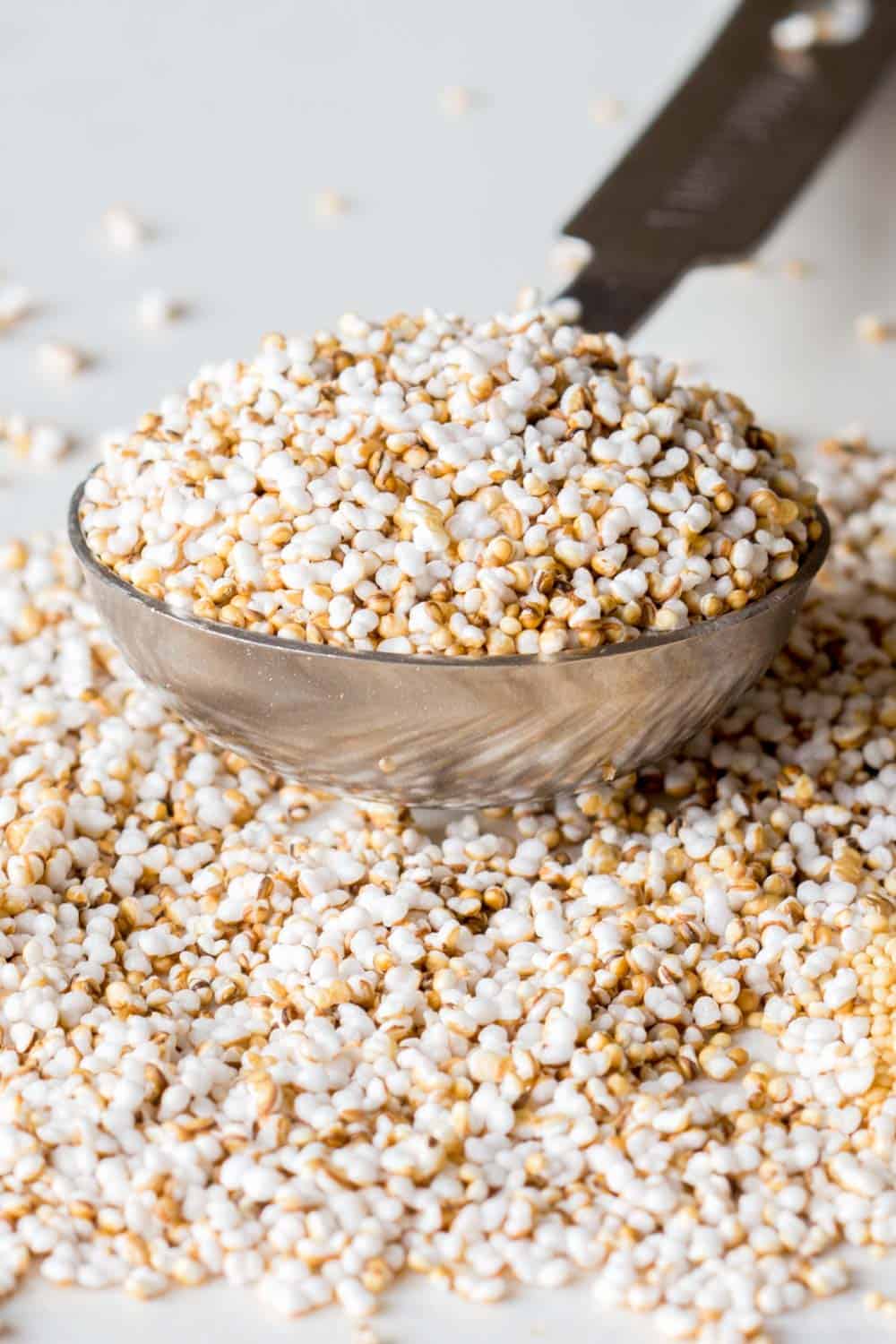
It’s hard to keep up with the long list of “superfoods” out there but this one should definitely make your list. Amaranth is very similar to quinoa. Both seeds are naturally gluten-free and very high in protein.
In case you’ve never heard about Amaranth before, let’s get to the basics:
What is Amaranth?
It’s often called a “pseudograin” because it’s not technically a grain but rather a seed. Exactly like quinoa. Amaranth was a staple food for the Aztecs and has been cultivated for thousands of years.
Today, most Mexicans consume it in a candy bar called “alegría”, which translated means joy. It is basically popped amaranth mixed with piloncillo (raw cane sugar).
The seeds are even smaller than quinoa seeds. And as opposed to quinoa it doesn’t fluff when cooked in water but rather becomes a sticky mush like oats in porridge.
In small amounts, it is an excellent thickener for soups, sauces, and jams.
Is amaranth gluten-free?
YES! Amaranth is naturally gluten-free because it isn’t a grain. If you are gluten intolerant, even more reason to incorporate amaranth into your diet. Together with quinoa, it’s the best substitute for any grain.
Amaranth is also lower in carbohydrates than for example rice or pasta. So if you are following a low-carb diet this is an amazing side dish for you.
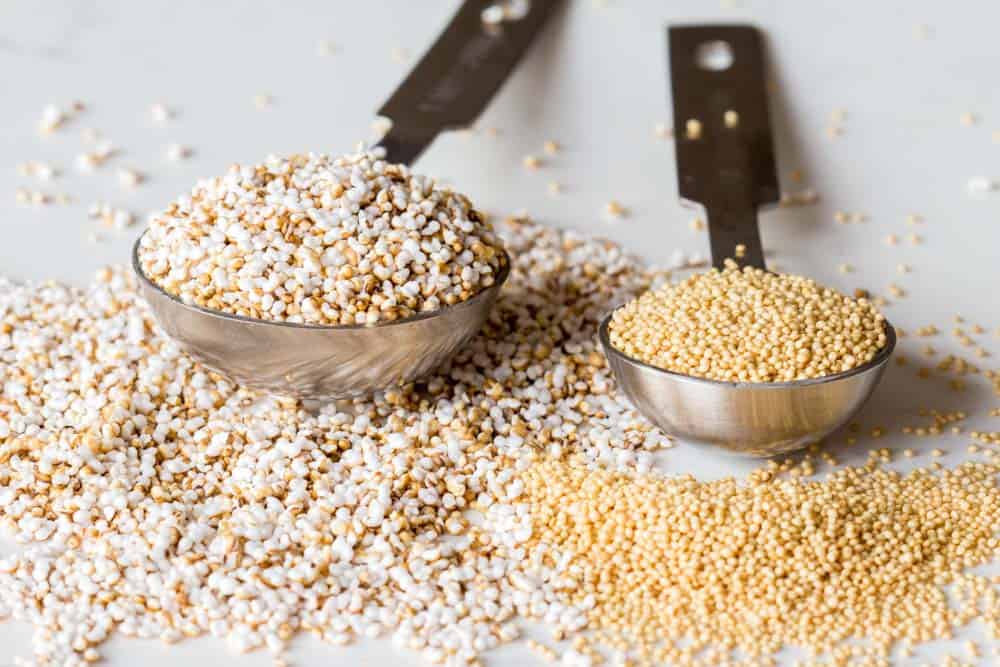
Can amaranth be eaten raw?
Well, it “can”, but there is no point. We can’t digest raw amaranth. It’s like eating raw rice or raw beans. It’ll pass right through our digestive tract without change.
It’s necessary to either cook it or puff it so we can digest it and enjoy the benefits of this amazing superfood. To cook it, you basically cook it just like quinoa or grains. Put Amaranth and water in a saucepan in a 1-2 ratio, bring to the boil, reduce heat to low, and simmer for 15-ish minutes or until all water is absorbed.
It becomes all gelatinous and mushy so eat it right away either as porridge with nuts and fruit or with some salt as a side dish.
I’m not a big fan of cooked amaranth which is why I always puff it. The nutty taste of the seed is enhanced and it tastes divine mixed into all kinds of dishes.
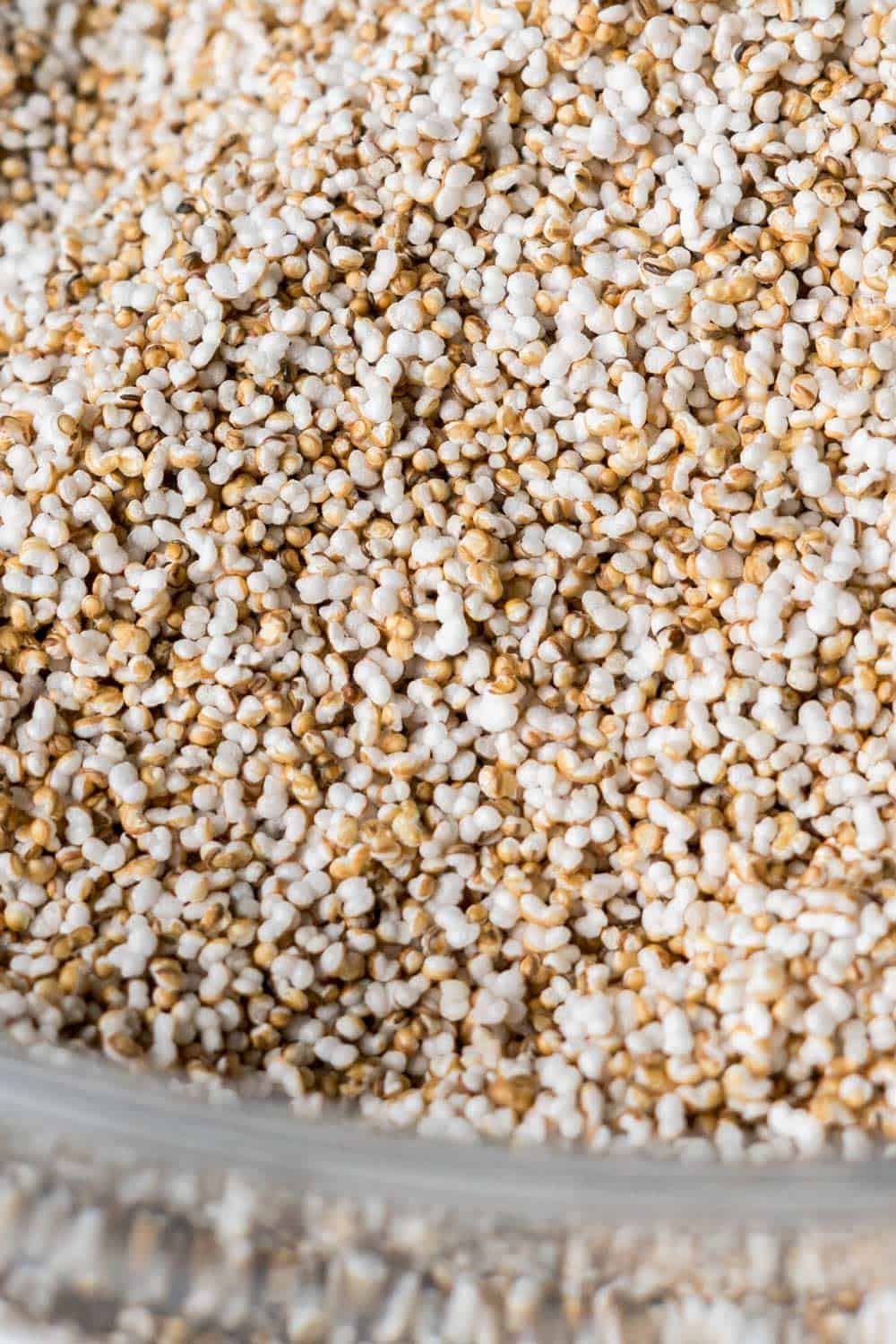
How to puff amaranth
It’s easier to make popped amaranth than popcorn. With popcorn, it’s kind of a faith thing. You place the kernels in the pot then you close the lid and pray. You can’t really see what’s happening in the pot. Haha.
With Amaranth it’s different. You do not add a lid. You want to prevent steam building up in the dry pot so no lid! The bad thing about this is, some seeds jump right out of the pot. The good thing, you keep an eye on your seeds and get them to pop beautifully.
Now there are a couple of nitty gritty details to ensure success. And here goes a big shout out to my amazing Mexican husband who did all the testing for me. It was his idea to post this blog post and the tips and tricks are all thanks to his research and testing :)
- use a high pot to avoid too many popped amaranth seeds shooting all over the place.
- the temperature has to be “PERFECT” so all the seeds immediately puff but none burn. You might have to toss the first two batches you try puffing until you find the perfect temperature of your stovetop. Too hot and they all pop but also all burn ahead of time. Not hot enough and they don’t pop but just burn. On my induction stovetop that goes from 1-9 and with cast iron pot I need to preheat my pot for about 5 minutes on 7 and then the amaranth pops perfectly.
- shake the pot often to get all seeds moving to the hot spots of the pot bottom and pop evenly without the popped ones burning.
What to make with popped Amaranth
You can eat popped amaranth just like that. My kids love a mix of just popped amaranth a few maple flakes to sweeten and they spoon it all out of a bowl. It’s a little dry for me like that.
I love adding it to granolas or salads. I also love making Tuna Patties with it and this Midnight Snack that is TO DIE FOR.\

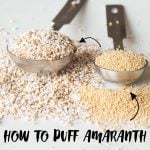
Popped Amaranth
Ingredients
- 1/2 cup amaranth seeds
Instructions
- Preheat a high pot over medium-high heat.
- Spread about 1 Tablespoon at the time as evenly as possible on the bottom of the hot pot.
- Wait for the seeds to pop. This should be quite immediate. If they don't pop right away, the pot wasn't hot enough and the seeds won't pop and just burn. Discard that batch and start over.
- Once the popping starts, shake the pot to ensure all seeds pop and the popped seeds don't burn.
- Once the puffing ceases remove the popped amaranth and put into a sieve to shake out the unpuffed seeds.
- Then add the popped amaranth to a bowl and repeat the same process until all amaranth is popped.
- For every Tablespoon of raw amaranth you'll get about 2 Tablespoons popped amaranth.


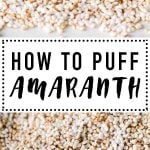
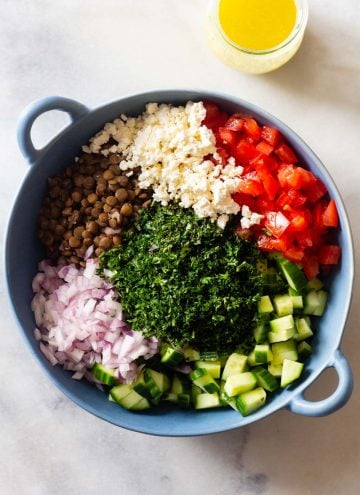 Easy Lentil Salad
Easy Lentil Salad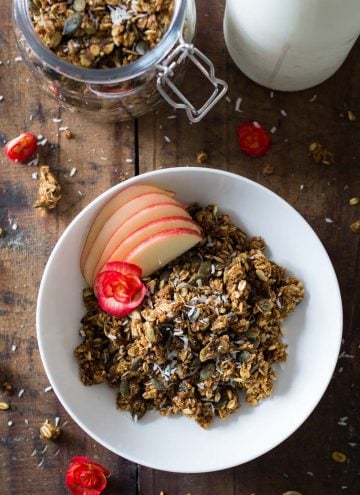 Healthy Pumpkin Granola
Healthy Pumpkin Granola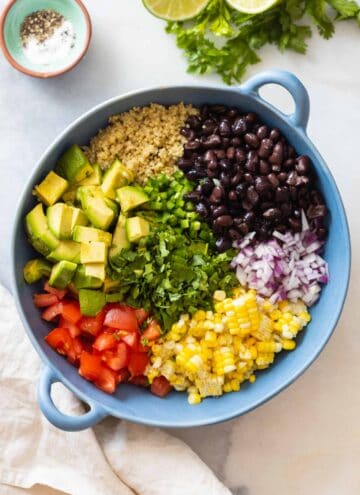 Mexican Quinoa Salad
Mexican Quinoa Salad
Jaimie says
I’m T2D diabetic and worried that this will spike my blood sugar. Does anyone else have any experience with this?
Lorena Grater says
Unfortunately, I am not very knowledgeable with diabetes. I can only tell you is that it apparently is rather high on the glycemic index.
Catrina says
When we lived in the US, I struggled to find popped amaranth to make my Mexican husband’s favorite amaranth meal. I came across your site when I was searching for an easy way to make popped amaranth from seeds and found this post to be super informative and helpful! We now live in Mexico where popped amaranth is easy to come by, but this post allowed me to spoil my husband with one of his favorite meals when we could only find amaranth seeds in the US. Thanks, Lorena!
Susanna says
Here is the way to tell if the seeds are ready to harvest. When you see the plant blooming with tiny yellow things (petals?), squeeze the flower lightly with your hand. If some seeds come out it is ready.
Anita flannery says
This is my first time , having only come accross this grain earlier today . I am absolutely gobsmacked not to have come accross it before . Thank you to the lady with the Mexican husband at the start of this article, you are amazing. I am going to order some seeds today as well as some ready puffed so as to start the bread recipe I have come accross . Also will try porridge with it . Please keep informing us about these different products as us , living from supermarket foods , need this education. Thank you again . I will also try to find your recipe for the tuna patties. Again , keep informing us please and a massive THANK YOU
Lorena Grater says
You are very welcome :) I’m so happy to read you enjoyed my post and Amaranth.
Mark Shlosberg says
I love baking sourdough bread and frequently will add toasted amaranth seeds to the dough (1 – 2 tablespoons to a 1 pound loaf of bread) for a nutty taste and texture.
Nc says
A fun thing to try! I found the popped amaranth was only marginally larger than the popped part – you need a sieve of very specific dimensions to separate them. I had to just use popped and I popped seeds together!
Kerry P. Shultz says
Sorry! Keep the strainer right side up so it sits in the saucepan. I haven’t popped the amaranth grain for a few months because I dried the last batch too long and it won’t pop. I am using the one kg jar of it though, in my morning oats and quinoa, until it’s finished. I soak the new batch 24 hours to remove outer coating that contains bad stuff. Then dry in oven on lowest heat checking after a while as it dries, mindful to not dry too much.
Kathy says
I have love lies bleeding amaranth growing in my garden. This will my first attempt in doing something edible with it. My question is: can I just go out and cut a flower/seed stem and use it right then OR do I need to process it someway before I can pop it or cook with the seeds?
Lorena Grater says
Oh gosh, Kathy, I wish I could be of more help but I have zero experience in planting and harvesting Amaranth. I don’t have a garden so I’ve never been able to experiment. I don’t have any advice here I’m afraid.
Teri says
Amaranth needs to be dried before using. When they start turning red, periodically go out with a bowl and shake the seed head. Ripe ones will fall off.
Sophie says
Going to add this to granola! Do you add it after baking the rest of the granola or do you add the popped amaranth into your mixture and bake together? Thanks!
Lorena Grater says
You can definitely add it to the mix of all ingredients and then bake. The longer you bake it the harder it will get. If you like it soft, then add after. If you like it crunchy add it with all other ingredients.
Ruth Berk says
We used a Twirly Gig popcorn popper and it worked perfectly!!!!!
Lucas says
I’m just here to comment that it can be eaten raw, in fact, a study (that I will not link to not be marked as spam) proved soaked and sprouted amaranth has less antinutrients than cooked! And even the completely raw has very little antinutrient density at 0.09 to 0.1%.
Wally says
Hi Amaranth advocates. Some time ago I posted a message concerning the failure of Amaranth to “pop”, and your websites author, Lorena, suggested it could be because the seeds were too old. We got the seeds in a gallon jar from an acquaintance and I planted some of the seeds. It appears that different species of seeds were in the same jar. Now one of the plants is unusually tall (about 10 feet-3 meters) and will yield cup fulls of seeds when ready(?) to be harvested.-
I’ve looked on the Internet to try and identify this particular species of plant and it appears to be Amaranthus australis.
Ours looks like this and it appears that the green “flowers” will remain that color, so I don’t know exactly when to harvest them for the seeds Since we live in southern California it also seems like we may not be in an area others imply is not good for growing this particular species. But results speak for themselves.
At any rate we will now have fresh seeds with no problem “popping”.
Wally says
An update to my previous messages, regarding harvesting amaranth seeds.
There seems to be misinformation on the Internet on how to go about this. One source stated to rub the seed pods between your fingers onto a flat area. From there merely blowing lightly across the seeds would cause the chaff to separate. I didn’t find this to be effective.
First I let the flower dry. Then I rubbed the seed pods between my fingers into a sieve 7” in diameter with 1/32” openings, I shook the sieve back and forth into the plastic bowl. A lot of chaff entered the 7” bowl as well as the seeds. I had taken only one of the “flowers” from the amaranth, which had remained green (?). The remaining chaff appeared to consist of what I would describe as a seed pod that held only one seed.
Then I went outdoors and blew into the bowl. The chaff, being very light, floated away. I had to repeat this process about 3 times to get nearly all of the chaff. What remained were about 2 THIMBLES FULL OF SEEDS, yellow to orange in color. Because of the color it was easy to tell that most of the seeds remained, as the chaff was a light brown in color. There were some tiny twigs that held the seed pods that also went into the sieve. These remained in the sieve.
Andrea says
I may be missing something but under nutritional information it says that there are 358 calories in a serving but I don’t see where it tells what a serving size is.
Lorena says
1/2 a cup of amaranth gives you 1 cup puffed amaranth and that has 358 calories.
Wally says
The amaranth is growing quite large. There is a difference in the leaf color. Some are red. It seems that maybe a different variety was growing in the field where the seeds were harvested. Looking into it I found the red leaves are more edible with a tangy flavor.
Also, we have some geraniums that were getting destroyed by ground worms that come out at night. I bought some Bayer Advanced Vegetable & Garden Insect Spray on the advice of a nursery we use. The geraniums recovered, and I discovered in the process that the spray appears to be a stimulant. So I used it on the amaranth seedlings and they also appeared to be stimulated to grow faster.
However, it is hot here and I also discovered that the spray damages the plant during daytime hours when it is hot. That’s just a tip to those here who might be inclined to grow amaranth. I believe it has made some of the seeds sprout that wouldn’t have otherwise. Only use a little of this spray as a stimulant after sundown.
Francis Katusa says
Did you check the chemicals in the Bayer application?
Priya says
I’d like to try this! Perhaps a splatter screen can cover the pot but still allow steam to escape (?) I’ve seen large ones at a dollar store.
Kerry P. Shultz says
I typed a lengthy reply to you but it didn’t post it. So you have the idea of a splatter pan. I found using a metal strainer turned upside down, one that fits the pot, stops the popping grain popping out perfectly. I found my mother’s old small brown glass saucepan really good for popping. I have the heat on between 15-20 as seen on a clock works beautifully!